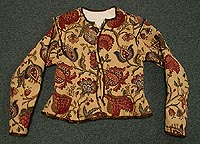
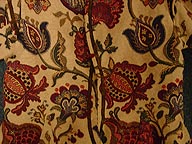



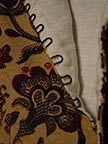
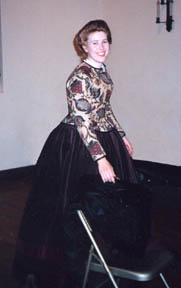
Item a petticoate of brown velvet with red vellat guards thereto and a jacket "broidered" with many silks, with small weltes of brown taffetie thereto.
This is a recreation of an outfit which would have been worn by a gentlewoman of modest means at the end of Elizabeth's reign, around 1600 to 1604. It is a jacket, or "waistcoat", and a separate velvet petticoat skirt. The skirt is cartridge-pleated to a band, and is designed to be worn over a french farthingale--not the vast farthingales worn at court, but a more modest farthingale suitable to the wearer's station. Under the skirt and jacket is a linen "petticoat bodies", a petticoat pleated to a sleeveless bodice. This bodice both supported the petticoat, and supported/flattened the bosom of the woman wearing it. A linen "ruffed partlet" goes with this (though I'm not wearing it in the picture.) A close-fitting white linen smock gathered to a is worn underneath.
Several jackets of this type survive, thanks to the elaborate crewel embroidery that made them items to treasure, rather than items to re-make into something more fashionable. The waistline was low at the beginning of the 17th century, and rose through the next two decades. The cut of the jacket remained otherwise the same, for the most part. Some portraits show the petticoat worn over the jacket.
The hooks and eyes are metal. They were sewn on like the hooks in a similar crewelwork jacket in the Victoria and albert museum: the hooks and eyes are sewn to the outer fabric, and most of the hardware hidden beneath a linen lining. The jacket is edged and trimmed with a small strip, or "welt" of brown shot taffeta hand-applique'd onto the fabric.
As the pattern was woven into the fabric, The motifs were cut out and applique'd over the seams to preserve the illusion of embroidery.
Jacket Patterns & Sources
I looked at several jackets to find the pattern I wanted. There's an embroidered jacobean Jacket in the Burrell Collection, one that used to be in the Ulster Museum Costume collection before it was destroyed, a couple jackets from the Metropolitan Museum of Art, one in the Suffolk Collection , and one in the Victoria & Albert Museum.. I also looked at jacket patterns in Arnold's Patterns of Fashion.. I used the jacket in the Ulster Museum for the basic pattern of mine. I moved the side back seam more under the arm so that the break in the fabric pattern wouldn't be as noticeable. As I'm more busty than the original women the jackets were made for, and as the cotton upholstery fabric didn't ease and stretch like wool will, I had to put slight darts into the front pieces of the jacket for it to fit properly. These I disguised with appliqued fabric.
Pictures
Skirt Patterns & Sources
The skirt is a simple rectangle of fabric cartridge-pleated to a waistband. I drafted the basic skirt pattern after the pattern for the black satin petticoat (c. 1615) on page 49 of Arnold's Patterns of Fashion. I used a french farthingale the size of that worn by the effigy of Martha Suckling, c. 1610 .
Pictures
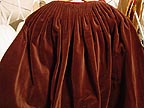 |
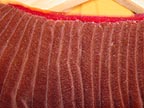 |
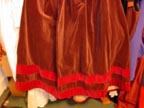 |
| A close-up of the skirt | Close-up of the cartridge- pleating at the waist |
Close-up of the guards at the bottom of the skirt |
Anthony, Ilid. "Clothing given to a Late 16th Century Servant in Wales", Costume 14, 1980.
Arnold, Janet. Patterns of Fashion: The Cut and Construction of clothing for men and women c. 1560-1620. MacMillan,©1986
Arnold, Janet. Queen Elizabeth's Wardrobe Unlock'd. WS Maney & Son, ©1988
Ashelford, Jane. A Visual History of Costume: The Sixteenth Century. BT Batsford Ltd, ©1983
Honig, Elizabeth Alice. Painting and the Marketplace in Early Modern Antwerp. Yale University Press, ©1998
King, Donald. The Victoria and Albert Museum's Textile Collection: Embroidery in Britain from 1200 to 1750. Abbeville Press, ©1993
Linthicum, M. Channing. Costume in the Drama of Shakespeare and His Contemporaries. Russell & Russell, ©1963.
Lyon, Eugene. Richer than we Thought: the material culture of 16th century St. Augustine. St. Augustine Historical Society, ©1992
McCrum, Elizabeth. "Destruction of Ulster Museum's Costume Collection", Costume 12, 1978. WS Maney & Son.
Payne, Blanche. History of Costume, 1st ed. Harper & Row, ©1965
Stern, Elizabeth. "Peckover and Gallyard, Two Sixteenth-century Norfolk Tailors", Costume 15, 1981. WS Maney & Son.
Waugh, Nora. The Cut of Women's Clothes 1600-1900.. Routledge, ©1968
Wilckins, Leonie von. "Kleiderverzeichnisse aus zwei Jahrhunderten in den Nachlaßinventaren wohlhabender Nürnbergerinnen", Waffen- und Kostümkunde, vol 13, 1972.